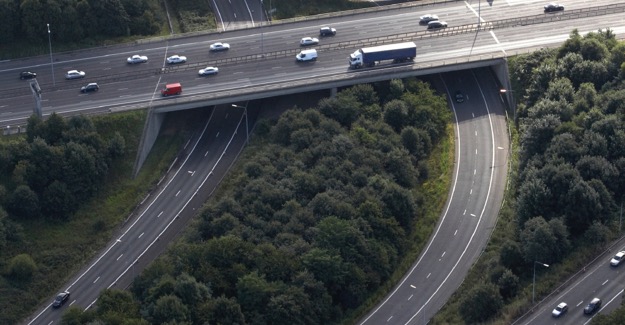Millions more cars, billions less investment, greater delay
There will be at least four million more cars on the UK’s roads in the next twenty-five years as the population grows by more than ten million.
The jump in people and cars will be accompanied by surges in traffic volume and delays on the UK’s roads, which are already the most heavily used in Europe.
Yet in the face of this scenario the government has significantly reduced road transport investment because of the recession and ministers have not explained what plans they have to cope with the bleak picture painted by their own numbers.
Official figures predict:
• The population will rise by more than ten million by 2035
• Based on the current rate of car ownership, there will be four million more cars on the road – and this doesn’t take account of the continued growth of car ownership amongst the poorer and older sections of society
• Traffic volume will go up by 43% by 2035
• Average delays will rise by 54% over the same period – on already congested roads the jams will be much greater
While the overall growth in traffic volume is forecast to be more than 40%, it will vary significantly region by region:
1. East Midlands 48%
2. South West 46%
3. East of England 45%
4= South East 44%
4= Yorks & Humber 44%
6. London 40%
7= North West 39%
7= Wales 39%
7= West Midlands 39%
10. North East 34%
The depressing future is outlined in a RAC Foundation report Keeping the Nation Moving. Professor Stephen Glaister, director of the RAC Foundation, said:
“Forget about Plan B, ministers do not even have a Plan A for dealing with the awful conditions forecast for the roads in the years ahead. It is a case of jams today, and even more jams tomorrow.
“The Department for Transport’s own figures show that by 2035 traffic is set to rise by almost 50% and delays by more than 50%. And these are only average figures. In some places, at some times of the day, the jams will be many times worse. The impact will be immense, not just on car drivers but also businesses trying to move their goods about.
“There needs to be a fundamental look at how the strategic and main roads are planned, developed, funded, operated and maintained; how the traffic that uses the road network is managed; and how that use is paid for.
“In the meantime there are scores of relatively small scale road improvement schemes which could be implemented as part of the growth agenda. They would deliver big benefits to significant numbers of people and businesses.
“We are not advocating a massive road building programme – we know we cannot build our way out of the nation’s forecast traffic problems, nor would we want to afford to. But what we do need from government is a clear long-term strategy. The Government’s own forecasts just cannot be ignored.”
The RAC Foundation – together with consultancy group Arup – has identified 96 unfunded road schemes that are currently sitting on the Department for Transport’s shelves. Together these would deliver significant returns, with the top ten projects all offering benefits of more than £6 for every pound invested. By comparison, HS2 (from London to Birmingham) offers a return of no more than £1.60 for each pound spent.
Top Ten unfunded projects giving best value for money Cost (£ million, 2010 values) Return on every £1 spent
A21 Tonbridge to Pembury Dualling (Kent) 117 £11
Leeds Inner Ring Road 43 £10
A18-A180 Link (Lincolnshire) 8 £9.70
Kingskerswell Bypass (Devon) 110 £8
A453 widening (M1 Junction 24 to A52 Nottingham) 153 £7.80
A47 Blofield to North Burlingham (Norfolk) 26 £7.10
A45 Westbound Bridge 13 £7
A5-M1 Link (Dunstable Northern Bypass) 146 £6.50
Evesham Bridge Maintenance (Worcestershire) 14 £6.40
A38(M) Tame Viaduct (West Midlands) 31 £6.30
HS2 (London to Birmingham – for comparison) 17,000 £1.60
Professor Glaister continued:
“The government talks about promoting growth, so why doesn’t it dust down its own files and make best use of taxpayers’ money by spending it on the 96 road schemes it has already judged to deliver fantastic returns?
“In isolation HS2 might have merit, but viewed alongside many of the road projects it seems very average. The currently unfunded schemes we have identified seem to tick all the right boxes yet government are turning a blind eye to them.
“So while a relatively few rich business men will benefit from a high speed rail link the majority of the population who have to drive to go about their business will find themselves in more and more congestion.
“The reality is that 91% of passenger miles travelled take place on the roads, mostly in private cars; just 8% is by rail.”
ENDS
Contact:
Philip Gomm – Head of External Communications – RAC Foundation
020 7747 3486 / 07711 776 448 / 020 7389 0601 (ISDN) [email protected] <mailto:[email protected]>
Notes to editors:
The RAC Foundation is a charity that explores the economic, mobility, safety and environmental issues relating to roads and responsible road users. Independent and authoritative research, carried out for the public benefit, is central to the Foundation’s activities.
The report is available on request and will be online at www.racfoundation.org <http://www.racfoundation.org> from the date of publication.
The RAC Foundation/Arup report referred to above is already on the RAC Foundation website:
<http://www.racfoundation.org/research/economics/131735>



